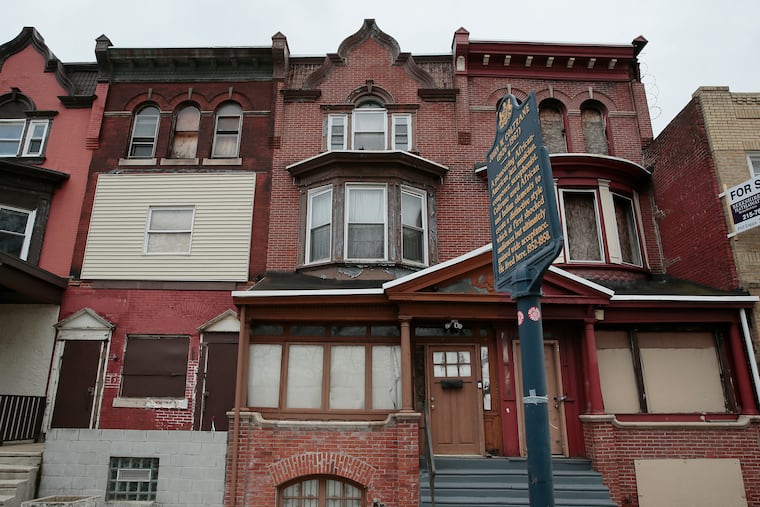Philadelphia jazz great John Coltrane’s house ‘at risk,’ preservationists say
The house is the first Philadelphia landmark to make Preservation Pennsylvania’s "at risk" list since 2017.

For over a decade, the paint-chipped Strawberry Mansion home where jazz legend John Coltrane once lived and honed his skills has echoed a silently somber tune, sitting in a state of disrepair on North 33rd Street.
And now, the house is officially at risk, according to a state preservation organization.
The John Coltrane House is listed on Preservation Pennsylvania’s 2020 roster of “at risk” sites, a designation intended to “draw statewide attention to the plight of Pennsylvania’s historic resources; promote and support local action to protect historic properties; and encourage funding and legislation that supports preservation activities,” according to the organization.
“Preservation Pennsylvania hopes to work with the owners and supporters in the local preservation and jazz communities to find a way forward for this property,” said Julia Chain, the organization’s associate director.
The home is the first Philadelphia landmark to make the nonprofit’s list since 2017, when Jewelers Row was dubbed “at risk.”
The designation doesn’t come with money or the promise of preservation — as evidenced by the fate of Jewelers Row, part of which is under demolition — but gives visibility and awareness to the site, said Faye Anderson, activist and director of All That Philly Jazz, a public history project.
» READ MORE: Part of Jewelers’ Row has been demolished for a Toll Brothers tower. What will happen to the rest?
Frustrated by the state of the home, Anderson nominated the Coltrane House for the 2020 list, which also includes the Strickler Farmhouse in York County and a 160-year-old stone bridge in the Lehigh Valley.
“It’s embarrassing to the legacy of John Coltrane to be on such a list,” Anderson said. “And it should be embarrassing to this city, too.”
The Coltrane House has been on Philadelphia’s Register of Historic Places since 1985, and has a blue marker dedicated to the "pioneering African-American jazz musician, composer, saxophonist.” In 1999, it became a National Historic Landmark. But neither title has kept the vacant home from falling into disrepair.
» READ MORE: How to explore Philly’s black history: A historical marker tour
The North Carolina native was in his mid-20s when he bought the three-story rowhouse at 1511 N. 33rd in 1952. He lived in the home while he was featured on Miles Davis’ 'Round About Midnight album in 1957 and produced Blue Train the following year. It was also at “Trane’s House” that he signed his first record contract, kicked heroin addiction, and composed tracks for the groundbreaking album Giant Steps. He’d go on to play with the greats of the day — Miles Davis, Thelonious Monk, and Dizzy Gillespie — before starting his own quartet.
After Coltrane left Philadelphia for the bright lights and soulful sounds of New York City in 1958, his cousin Mary Lyerly Alexander — to whom he dedicated a track on Giant Steps — maintained Trane’s legacy in Philly. Founding the John W. Coltrane Cultural Society, “Cousin Mary” hosted a series of backyard concerts at the home, introducing children across the city to jazz.
In 2004, Alexander moved into a nursing home, selling the property to jazz lover Norman Gadson, who died three years later. Gadson’s daughter, Aminta Weldon, is now responsible for the home, and has started a 501(c)3 nonprofit in an effort to rehab the landmark site.
Anderson said she worries for the historic house’s structure, and hopes Preservation Pennsylvania’s “at risk” designation will move the city to help protect the facade for years to come.
The issues with the Coltrane House are complicated, but not unique in a city like Philadelphia, a city spokesperson said, adding that the issue is “on the city’s radar, but unfortunately, our ability to address them using current resources is limited.”
The city’s power does not extend to compelling a property owner to maintain a cultural site, the spokesperson added.
The Department of Licenses and Inspections intends to visit the site within the coming weeks, a spokesperson said.
“It’s too important to wait. Time is not our friend,” Anderson said. "This property is associated with this jazz giant who belongs to the world, and it deserves that respect.”